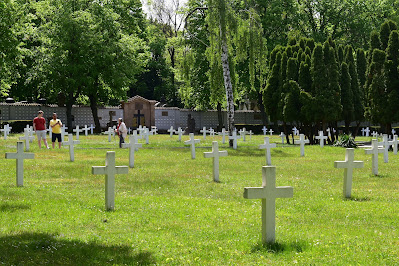Magnificent but over-touristed, Prague's magnificence springs from its being spared the devastation of war and from its hilly location. Architecturally, the area of the city covered by pre-war housing extends out from the historic centre far more than Warsaw. Both capital cities cover around 500 square kilometres, but the ring of post-war high-rise housing starts much closer to the centre of Warsaw; Warsaw's population density is about 50% higher than Prague's.
To give Varsovians a sense of Prague, imagine stretching Stary Mokotów all the way out to Piaseczno and Żoliborz all the way out to Czosnów and filling everything in between with 19th century mansions, modernist villas, parks and squares and broad tree-lined boulevards served by a dense network of trams and buses.
The history of Prague is mind-blowingly rich, paralleling many twists and turns in Polish history, yet is so different, despite the linguistic similarities between the two nations.
Because of its beauty, Prague has made its way up many people's bucket list; a must-see kind of a place, alongside Paris or Venice or Rome, regardless of any genuine interest they have (or not have) in European history or architecture.
The UNESCO World Heritage historic centre of Prague covers over 1,100 hectares. That's more than three times bigger than the UNESCO-listed old-town parts of Warsaw, Kraków, Zamość, Toruń and Gdańsk put together. [Warsaw's Old Town is a mere 25 hectares; Kraków's heritage sites total 150 hectares. Zamość boasts 75 hectares, Toruń a further 50 hectares, whilst Gdańsk (50 hectares) only makes it to the 'Tentative' list of UNESCO World Heritage sites.
This makes the historic centre of Prague a global mega-attraction; a destination that draws mega-crowds. As a result, its authenticity and its klimat, any deep spirit of place has long evaporated. My brother managed to visit Prague soon after the end of communism, before its Disneyfication. I did the Old Town on a Monday in April; it was already rammed with tourists. Weekends in July and August will be tourist hell. All the downsides of tourism. Profit = margin x volume.
Below: Charles Bridge in a sea of humanity (below). Tourists randomly stop to take selfies, so one has to watch out for them rather than the sights. I cannot reflect upon my experience or get into the historic groove. Despite being at the heart of "one of the world's most pristine and varied collections of architecture" (Wikipedia), I'm not experiencing it. I'm not feeling it. The klimat is not getting to me. What is getting to me? Crocodiles of visitors anxiously look for their tour guide's flag; blank faces turning this way and that to gaze for a second or two at this 15th century palace or that 13th century church before moving on. Families in horse-drawn carriages, all face-down in their phones. Shops selling rubber ducks, synthetic-fur geese, or 20cl souvenir bottles of Czech beer for €4. I cannot feel spirit of place under these conditions; I am continuously distracted. Pamphleteers hand out flyers for restaurants rather than Hussite tracts questioning the dogmas of the Church of Rome.

But move away from the top-ranked must-see spots for the Instagram and TikTok tourism de nos jours, Prague remains very much a living, working city with a character that you appreciate best away from the tourist throng.
This, I'd posit, is the epicentre of Europe, historically and culturally. The ebb and flow of empires and religions have washed against Prague's stones.
My post-war generation has thought of Europe in terms of East and West; since the end of the Cold War Europe has returned to a more typical course. Jonathan Meade's 2008 BBC TV documentary about northern Europe, Magnetic North, delineates a wine-drinking South and the beer- and spirits-drinking North as the two faces of our continent. Divided by climate which shapes attitude to life, Meades contrasts the pleasure-loving, sun-soaked South to the grim, Gothic North; austere and hard-working.
So – where sits Prague? Geographically, the Vltava flows into the Elbe which flows into the Baltic. Developmentally western, it was industrialised in the 19th century, with a wealth of home-grown engineers, architects and entrepreneurs. It has a beer-drinking culture par excellence. But lumping Prague together with a Brussels or a Copenhagen would be to miss its inhabitants' pohoda, or laid-back approach to life, which strikes me as being more Mediterranean than Baltic.
On three evenings in the tourist-free near-suburbs of Žižkov, Karlin and Staré Vršovice (think, say, Mokotów, Żoliborz or Saska Kępa), we'd sit in crowded bars filled with local folk enjoying life and beer and food and conversation on a scale unseen in Warsaw's suburbs. OK, the weather was perfect and the May Day holiday was approaching, but still, street life appeared as vibrant as in Southern Europe. Perhaps Prague's history (it was not repeatedly flattened and rebuilt) and its architecture (tenements on a human scale rather than London's sprawl of semi-detached housing or soulless tower blocks) are more conducive to popping round the corner for a beer and fried cheese and dumplings with friends than sitting at home in front of the TV of an evening.
Below: elementary school and daycare centre, Lyčkovo náměstí. Built in 1905.
I must return to Prague in mid-November or late-February; dark and damp, wet cobbles and – (I hope) empty streets. And the old Jewish cemetery won't be closed because of Pesach.






















































